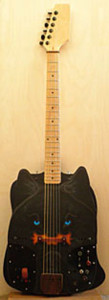Artwork you can play
The Nonprovisional Patent Application for this guitar arrived at the U.S. Patent and Trademark Office received on July 23, 2014. It has a removable artwork top, which has moderate acoustic output, and can be easily shaped and decorated to the owner’s desire. The prototype artwork soundboard shown here is supposed to look like a blue-eyed wolf.
It is literally “Artwork You Can Play”(tm).
Any number of pickups, in any position and orientation between the neck and bridge
Any number of pickups (up to the limit of available space) can be placed in almost any physical orientation between the neck and bridge. The usual guitar pickup, single-coil or humbucking, has only two degrees of freedom of adjustment, up or down beneath the strings at each end. This guitar allows that plus three more degrees of freedom, including position adjustments between the neck and bridge at each end and moving the whole pickup across the strings.
Note that the back is also removable, and can be cut to fit the musician’s body and needs. See the thigh hook on the bottom left of the 3rd image, and belly cut on the right.

Ten humbucking outputs
This prototype, the 4th in a series extending over several years, has four single-coil pickups, which have been modified to equalized the number of turns among them. One five-way lever switch produces series-connected combinations of two coils each, all humbucking. The second five-way switch produces parallel combinations of two coils each, all humbucking. A series-parallel switch switches the output between them. As a lever points moves in the direction of the neck to the bridge, the coil combinations become brighter. Series connections are warmer and louder than parallel connections.
12 tone capacitor choices and a linear/distortion pre-amp
This output is connected to a 12-way rotary switch with 11 separate capacitors, in parallel with the pickups (large red knob on the left, or 6-string side). The capacitors are chosen so that the peak frequency resonant with the pickup combination tends to decrease in steps equivalent to approximately four frets. Because the pickups sit beneath the top, this output connects to a battery powered pre-amplifier and distortion circuit.
The distortion circuit approximates tube distortion, a curve like an italic-f. The distortion control increases the severity of this distortion, and at the highest setting produces a string-popping effect. The Linear-Distorted switch picks between the linear and distorted outputs of this circuit, and passes the choice along to the output jack. To the best of one’s knowledge, no available pedal or amplifier produces the string-popping effect. But Paul demonstrates that it can be used to good effect.
240 tone and timbre settings from folk to metal
With a choice of 11 parallel tone capacitors or none, 10 humbucking pickup circuits from four single-coil pickups, and linear or distorted outputs, this prototype has 12x10x2 or 240 different settings for tone and timbre. Plus, it can be played acoustically, or with a contact microphone clamped to the edge of the artwork soundboard. It can be used, as is, in genres from folk to blues to country to jazz to rock to metal.
“If you can’t find something you like, you aren’t trying hard enough.”(tm)
Tulsa Jazz Guitarist Paul Humphrey plays and reviews the 4th prototype – See Parts 5 & 6



